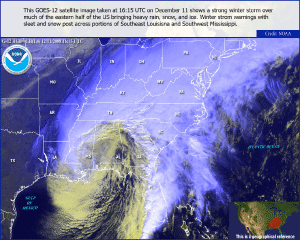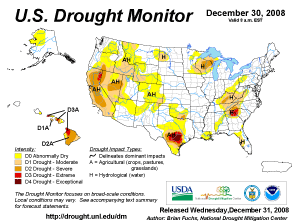
Global Hazards and Significant Events
December 2008
A rare snowstorm swept across parts of south Louisiana and Mississippi on December 11, blanketing the area with snow. Additional information can be found below.

As of December 30, severe to extreme drought was observed across parts of the Hawaiian Islands, the western continental U.S., and parts of Georgia and South Carolina. Meanwhile, severe to exceptional drought conditions were present across southern Texas.
In Moscow, temperatures on December 6 reached 9.4°C (48.9°F). This was the highest December temperature since meteorological records began (BBC News).

Heavy rain caused widespread floods across parts of Italy during December 11-15, claiming the life of four people and causing disruptions. Flash floods inundated streets, homes, and businesses in Rome, forcing the city to declare a state of emergency. According to reports, Rome received more than the average December rainfall when nearly 102 mm (4 inches) of rain fell over areas in Rome in a period of eight hours on the 11th (Associated Press/BBC News).
In northern Colombia, torrential downpours (which began December 13) left over 50,000 people homeless when the Magdalena River rose above the flood stage, inundating thousands of homes. The City of Plato in Magdalena Province was badly hit when the river flooded homes, roads, and crops and left over 20,000 people homeless (BBC News).
Heavy rain fell on the island of Mallorca on December 15-16, causing roads to close and forcing 120 people to evacuate their flooded homes. The heavy downpours are suggested to be the cause for the upper floors of a closed hotel to collapse, killing four workers (Reuters).
Across southern Mozambique, copious rain fell during December 28-31, leading to floods that forced thousands of people to evacuate their homes. According to reports, the worst hit area was the province of Inhambane where more than 500 mm (20 inches) of rain fell, triggering dangerous flash floods that damaged crops and immersed thousands of homes. One fatality was reported (BBC News).
Heavy rain fell in central and eastern Bolivia, prompting the overflow of rivers. The swollen rivers flooded roads and damaged homes (BBC News).
Abundant rainfall during November 22 to December 3 in southern parts of Brazil caused rivers to burst their banks and triggered mudslides. Heavy rainfall led to widespread floods that affected nearly 78,700 people as their homes were damaged or destroyed. It was reported that in just three days, over 500 mm (20 inches) of fell. This amount is the average amount for a period of four months. According to reports, 116 people were killed with 31 others missing (IFRC).
Heavy rain fell during December 1-11 across parts of northern Philippines, producing floods that inundated homes and claimed the life of one person (BBC News).
In Sri Lanka, flooding resulted by heavy rains during the first week of December caused more than 370,000 people to evacuate the affected areas (BBC News).

In Australia, severe storms affected parts of New South Wales and Queensland on December 7-8. The storms produced golf ball size hail and serious flooding that caused damage to properties (BBC News).
Across the southern contiguous U.S., severe storms produced heavy rain and tornadoes on December 10, damaging two schools and dozens of homes (Associated Press).

No reports of significant tropical cyclones were received during December 2008.
For 2008 basin tropical cyclone statistics, please refer to the following:
Australian Basin
North Indian Ocean Basin
Western North Pacific Basin
South Pacific Basin
South Indian Ocean Basin
Northeast Pacific Ocean Basin
Atlantic Basin

No reports of significant extratropical cyclones were received during December 2008.

A rare snowstorm swept across parts of south Louisiana and Mississippi on December 11, blanketing the area with snow. Nearly 20 cm (8 inches) of snow fell over parts of Louisiana. These conditions caused schools and bridges to close and left thousands of residents without power (Associated Press).
A significant ice storm wreaked havoc across New York and New England on December 12, disrupting electricity and leaving over 1 million homes and businesses without power. New Hampshire alone had as many as 320,000 residents without power, which according to reports it was described as the worst outages in 30 years (Reuters). Four fatalities were reported and parts of Massachusetts, New Hampshire, New York, and Maine declared a state of emergency (BBC News).
On December 17, a winter storm dumped as much as 91.4 mm (3.6 inches) of snow across Las Vegas, Nevada, prompting the closure of schools and highways. This was the largest December snowfall on record and the heaviest snowfall since January 1979 when a total of 190.5 mm (7.5 inches) fell (Associated Press).
A snow and ice storm on December 19 affected parts of the U.S. Midwest. Over 220,000 homes and businesses across Illinois, Indiana, and Ohio were left without electric services. No fatalities were reported (Reuters).
For more information on the U.S. Snow and Ice events, please visit the U.S. Snow and Ice Winter 2008/2009 page.
A major winter storm affected Japan on December 25, blanketing much of the country with snow. The adverse conditions caused flights to be cancelled, stranding over 6,000 people (BBC News).
 NOAA's National Centers for Environmental Information
NOAA's National Centers for Environmental Information

